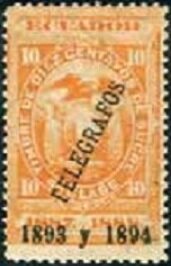Stamp: Coat of arms of Ecuador (Ecuador 1895)
Coat of arms of Ecuador (Ecuador 1895)
01 January (Ecuador ) within release Telegraphs - Fiscal stamps overprinted (1894-1897) goes into circulation Stamp Coat of arms of Ecuador face value 10 Ecuadorian centavo
| Stamp Coat of arms of Ecuador in catalogues | |
|---|---|
| Yvert et Tellier: | Yt: EC TE17a |
Stamp is square format.
Revenue stamp dated 1887-1888 and overprinted "1893 y 1894", further overprinted "TELEGRAFOS" diagonally in black HI 19Also in the issue Telegraphs - Fiscal stamps overprinted (1894-1897):
- Stamp - Coat of arms of Ecuador face value 10;
- Stamp - Coat of arms of Ecuador face value 10;
- Stamp - Coat of arms of Ecuador face value 10;
- Stamp - Coat of arms of Ecuador face value 10;
- Stamp - Coat of arms of Ecuador face value 10;
Stamp Coat of arms of Ecuador it reflects the thematic directions:
Birds (Aves), a subgroup of Reptiles, are the last living examples of Dinosaurs. They are a group of endothermic vertebrates, characterised by feathers, toothless beaked jaws, the laying of hard-shelled eggs, a high metabolic rate, a four-chambered heart, and a strong yet lightweight skeleton. Birds live worldwide and range in size from the 5 cm (2 in) bee hummingbird to the 2.75 m (9 ft) ostrich. They rank as the class of tetrapods with the most living species, at approximately ten thousand, with more than half of these being passerines, sometimes known as perching birds. Birds are the closest living relatives of crocodilians.
Birds of prey or predatory birds, also known as raptors, are hypercarnivorous bird species that actively hunt and feed on other vertebrates (mainly mammals, reptiles and smaller birds). In addition to speed and strength, these predators have keen eyesight for detecting prey from a distance or during flight, strong feet with sharp talons for grasping or killing prey, and powerful, curved beaks for tearing off flesh. Although predatory birds primarily hunt live prey, many species (such as fish eagles, vultures and condors) also scavenge and eat carrion
A coat of arms is an heraldic visual design on an escutcheon (i.e. shield), surcoat, or tabard. The coat of arms on an escutcheon forms the central element of the full heraldic achievement which in its whole consists of shield, supporters, crest, and motto. A coat of arms is traditionally unique to an individual person, family (except in the United Kingdom), state, organisation or corporation.
A flag is a piece of fabric (most often rectangular or quadrilateral) with a distinctive design that is used as a symbol, as a signaling device, or as decoration. The term flag is also used to refer to the graphic design employed, and flags have since evolved into a general tool for rudimentary signalling and identification, especially in environments where communication is similarly challenging (such as the maritime environment where semaphore is used). National flags are patriotic symbols with varied wide-ranging interpretations, often including strong military associations due to their original and ongoing military uses. Flags are also used in messaging, advertising, or for other decorative purposes. The study of flags is known as vexillology, from the Latin word vexillum, meaning flag or banner.
Telegraphy is the long-distance transmission of messages where the sender uses symbolic codes, known to the recipient, rather than a physical exchange of an object bearing the message. Thus flag semaphore is a method of telegraphy, whereas pigeon post is not. Ancient signalling systems, although sometimes quite extensive and sophisticated as in China, were generally not capable of transmitting arbitrary text messages. Possible messages were fixed and predetermined, so such systems are thus not true telegraphs.






